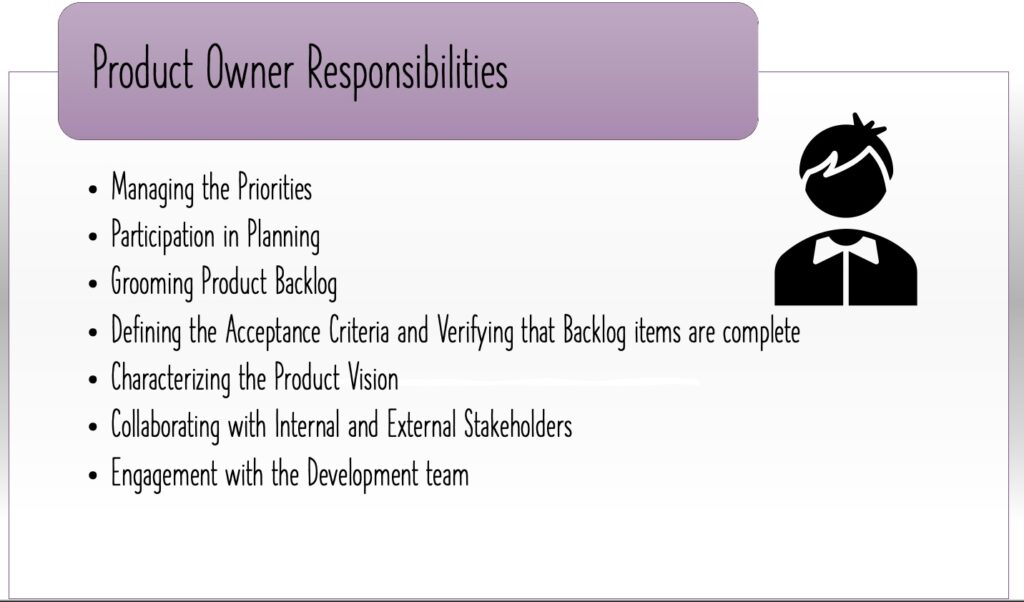The Product Owner is entitled to be one of the most critical person in product leadership. Also, in the scrum framework, the Product Owner is one of the three prominent roles (Scrum Master, Product Owner, Development team).
video tutorial on agile product owner responsibilities
The Product Owner needs to look into two aspects of the product simultaneously.

- One of the aspects is understanding the priorities and needs of customers, users, organization leads and working in the direction to ensure the right product is developed.
- Another aspect is communicating and working with the development team regarding what needs to be developed and the order. The Product Owner is also responsible for verifying through acceptance criteria that features are complete (meets Definition of Done).
READ MORE: Definition of Done and Definition of Ready
The Product Owner is a full-time job with a lot of duties to be fulfilled. Let us now look into some of the significant responsibilities of the Product Owner’s everyday work.

Managing the Priorities #
The Product Owner is responsible for defining the priority for the product backlog features and the upcoming release work. He is the one who takes the required decisions related to priority on releases- WHAT goes out and WHEN. This decision-making is done to ensure that the right features are developed. He also takes care that the delivery pace is appropriate for the customers.
The Product Owner also keeps a keen eye to maintain a good return on investment from the sprint and release deliveries.
The Product Owner is the one to prioritize which customer gets the release first. The Product Owner involves the team in making decisions but is the one to decide based on customers’ returns and priorities.
Participation in Planning #
Product Owners play a vital role when it comes to planning. A Product Owner is involved in all planning activities required in the project, including release planning, sprint planning, or portfolio planning. The Product Owner gets engaged with internal and external stakeholders at every step. Hence, he is aware of the organization’s decisions, product features, and customer requirements; therefore, he plays a significant role in providing valuable inputs to the development team regarding suitable timelines for specific releases.
Grooming Product Backlog #
A Product Owner takes the proprietorship to groom the product backlog. Grooming a product backlog includes:
- The user story creation.
- Estimating the work items.
- Prioritizing the product backlog items.
Though he does not perform all the grooming tasks independently, the Product Owner has the team involved with him. For example, the team will do the estimations based on their expertise, experience, and Product Owner’s guidance. The Product Owner might not write all the user stories but takes help from other team members like scrum master, and others can also contribute.
However, the Product Owner holds the responsibility for these activities and ensures that they happen.
Defining the Acceptance Criteria and Verifying that an item is complete #
Another responsibility of the Product Owner’s job is defining the acceptance criteria for each user story.
Acceptance criteria are the conditions that should be satisfied before saying that the user story is complete. A Product Owner is the one who specifies this criterion. It’s the product owner’s responsibility to ensure that the acceptance tests are ready before the upcoming sprint planning meeting.
Product Owner might write the acceptance test cases on his own or guide the development team on how to get these test cases ready.
Along with defining the acceptance criteria, a Product Owner also confirms if a particular product backlog item is complete during the sprint review.
Characterizing the Product Vision #
The Product Owner is the one who guides the team with the product vision. He also makes sure that the team is aware of the high-level goals of the organization and all the development activities are in line with the business needs.
The Product Owner might also get a user story mapping visual for the team with the help of scrum master to provide them with a way to envision massive backlog work and upcoming priorities.
Collaborating with Internal and External Stakeholders #
The Product Owner is the primary voice for all the stakeholders, internal as well as external.
Internal stakeholders: are the senior executives, product managers, sales team, etc.
External stakeholders: are customers, the user community, or other third parties. A Product Owner works with them closely to get the business objectives and vision for the product.
Engagement with the development team #
The Product Owner should frequently collaborate with the development team. If the Product Owner is unaware of what the development team is focusing on, the essential feedback might get delayed, leading to non-expected results. Hence, while the development team is working, the Product Owner should be engaging with the team to verify if they are heading in the right direction.
Closing #
The Product Owner role is a good blend of authority and responsibility. His day-to-day life is full of different activities involving planning, setting up priorities, writing new backlog items, refining the backlog items, guiding the team with product vision, and many more. It is quite possible that in some organizations performing this role by a single person is quite difficult. Hence, in a few organizations, a team of people might also serve the Product Owner’s duty.
We hope this article helped you in understanding the responsibilities of the Product Owner in Agile development. Good Luck!!!